2017 MERCEDES-BENZ G-Class ignition
[x] Cancel search: ignitionPage 13 of 286
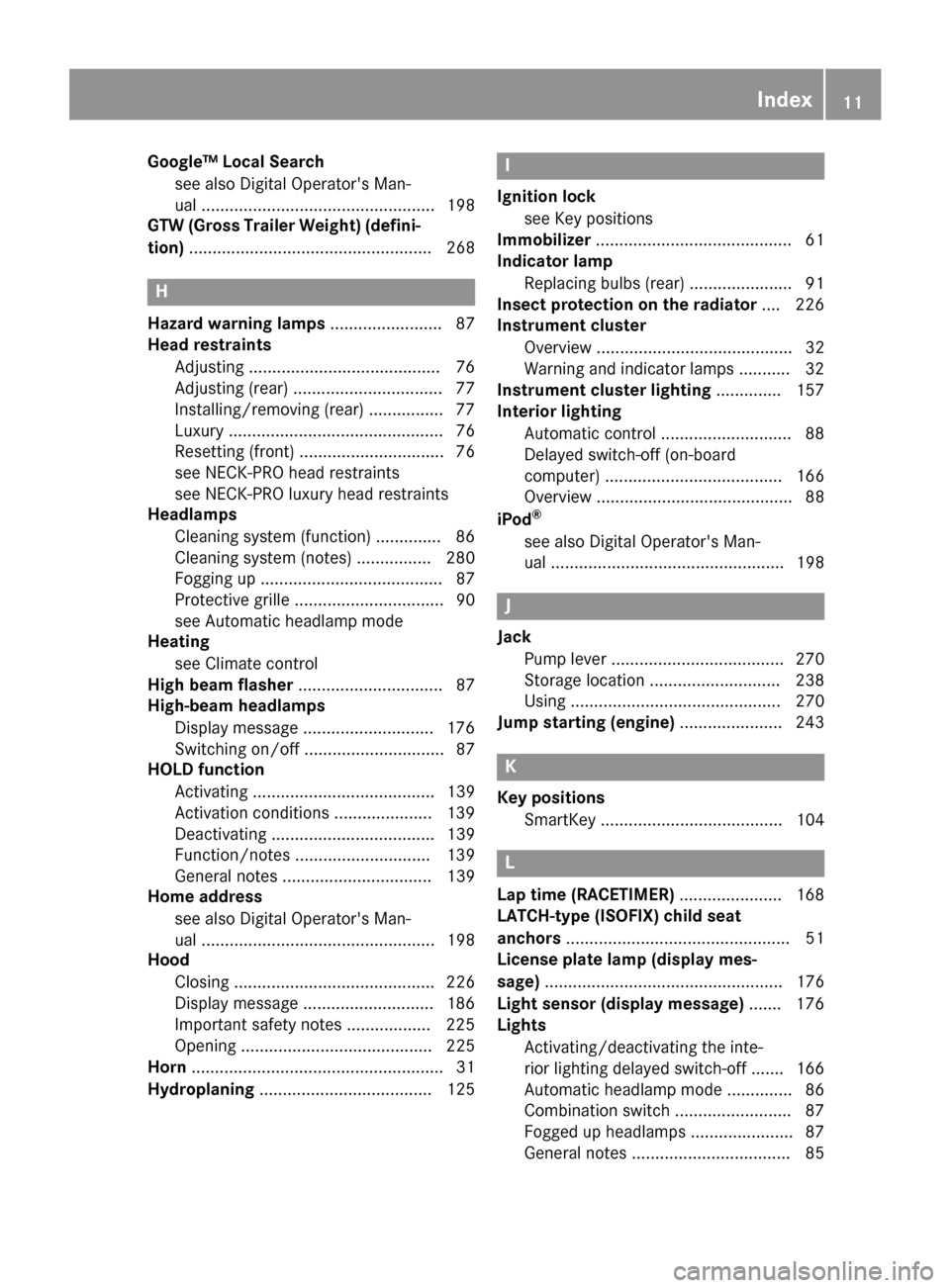
Google™ Local Searchsee alsoD igital Operator's Man-
ual. ................................................. 198
GTW (Gross Trailer Weight) (defini-
tion) .................................................... 268
H
Hazard warning lamps ........................ 87
Head restraints
Adjusting .........................................7 6
Adjusting (rear )................................ 77
Installing/removing (rear )................ 77
Luxur y.............................................. 76
Resetting (front) ............................... 76
see NECK-PR Oheadr estraints
see NECK-PR Oluxuryh eadr estraints
Headlamps
Cleaning system (function) .............. 86
Cleaning system (notes) ................ 280
Fogging up ....................................... 87
Protective grill e................................ 90
see Automatic headlamp mode
Heating
see Climate control
Hig hbeamf lasher ............................... 87
High-beam headlamps
Display message ............................ 176
Switching on/off .............................. 87
HOLDf unction
Activating ....................................... 139
Activation conditions ..................... 139
Deactivating ................................... 139
Function/note s............................. 139
Generaln otes ................................ 139
Home address
see also Digital Operator's Man-
ual.................................................. 198
Hood
Closing ........................................... 226
Displa ymessage ............................ 186
Important safety notes .................. 225
Opening ......................................... 225
Horn ...................................................... 31
Hydroplaning ..................................... 125
I
Ignitionlock
see Key positions
Immobilizer .......................................... 61
Indicator lamp
Replacing bulb s(rear) ...................... 91
Insect protection on the radiator .... 226
Instrument cluster
Overview .......................................... 32
Warning and indicator lamps ........... 32
Instrument clusterl ighting .............. 157
Interior lighting
Automati ccontrol ............................ 88
Delayed switch-off (on-board
computer) ...................................... 166
Overview .......................................... 88
iPod
®
see also Digital Operator's Man-
ua l.................................................. 198
J
Jack
Pump lever ..................................... 270
Storage location ............................ 238
Using ............................................. 270
Jump starting (engine) ...................... 243
K
Keyp ositions
SmartKey ....................................... 104
L
Lap time (RACETIMER) ...................... 168
LATCH-type (ISOFIX )child seat
anchors ................................................ 51
License plate lamp (display mes-
sage) ................................................... 176
Light senso r(display message) ....... 176
Lights
Activating/deactivating the inte-
riorlighting delaye dswitch-off ....... 166
Automati cheadlamp mode. ............. 86
Combination switch ......................... 87
Fogged up headlamp s...................... 87
Generaln otes .................................. 85
Index11
Page 19 of 286

Convenience opening feature .......... 70
Display message ............................ 187
Door central locking/unlocking ...... .63
Important safety notes .................... 63
Loss .................................................6 6
Mechanical key ................................ 64
Overview .......................................... 63
Positions (ignition lock) ................. 104
Problem (malfunction) ..................... 66
Starting the engine ........................ 105
SMS
see also Digital Operator's Man-
ual .................................................. 198
Snow chains ...................................... 253
Socket (12 V)
Cargo compartment. ...................... 213
Front-passenger footwell ............... 212
General notes ................................ 212
Rear compartment. ........................213
Sound
Switching on/off ........................... 199
Spare fuses ........................................ 249
Spare wheel
Spare wheel bracket at the rear .... 239
Stainless-steel spare hub cap ........2 39
Special seat beltr etractor.................. 50
Specialist workshop ............................ 27
Speedometer
Digita l............................................ 160
In the Instrument cluster ................. 32
Segments ...................................... 157
Selecting the displayu nit ...............165
Standingl amps
Display message ............................ 176
Switching on/off .............................. 86
Starting the engine
Important safety notes .................. 104
Steering (display message) .............. 187
Steering wheel
Adjusting (electrically). .................... 80
Buttons (on-board computer) ......... 158
Cleaning ..................... .................... 236
Important sa
fety notes .................... 79
Paddle shifters ............................... 114
Steering wheel heating .................... 80
Storing settings (memory func-
tion) ................................................. 83 Steering wheel heating
Indicator lamp (malfunction) ............ 80
Steering wheel paddle shifters ........114
Stopwatch (RACETIMER) ................... 168
Stowage areas ................................... 205
Stowage compartment
Door stowage compartment .......... 206
Stowage compartments
Armrest (under) .............................2 06
Cu ph olders ................................... 210
Glove box ....................................... 205
Important safety information ......... 205
Stowag enet ................................... 206
Stowag epockets ........................... 206
Stowage net ....................................... 206
Summer opening
see Convenience opening feature
Summer tires
In winter ........................................ 253
Sun visor ............................................ 210
Surround lighting (on-board com-
puter) ..................................................1 65
SUV
(Sport Utility Vehicle) ....................... 26
Switchin gair-recirculation mode
on/off ................................................. 101
Switchin gonmedia mode
Via the device lis t.......................... 203
T
Tachometer ........................................ 157
Tail lamp
Replacing bulb s............................... 91
Tail lamps
Displa ymessage ............................ 176
Tank content
Fuelgauge ....................................... 32
Technical data
Capacities ...................................... 276
Drawba rloa d( maximum) ............... 284
Information .................................... 274
Trailer load s................................... 284
Vehicl edata. .................................. 281
Telephone
Accepting acall. ............................ 163
Authorizing amobilephone (con-
necting) ......................................... 202
Index17
Page 33 of 286
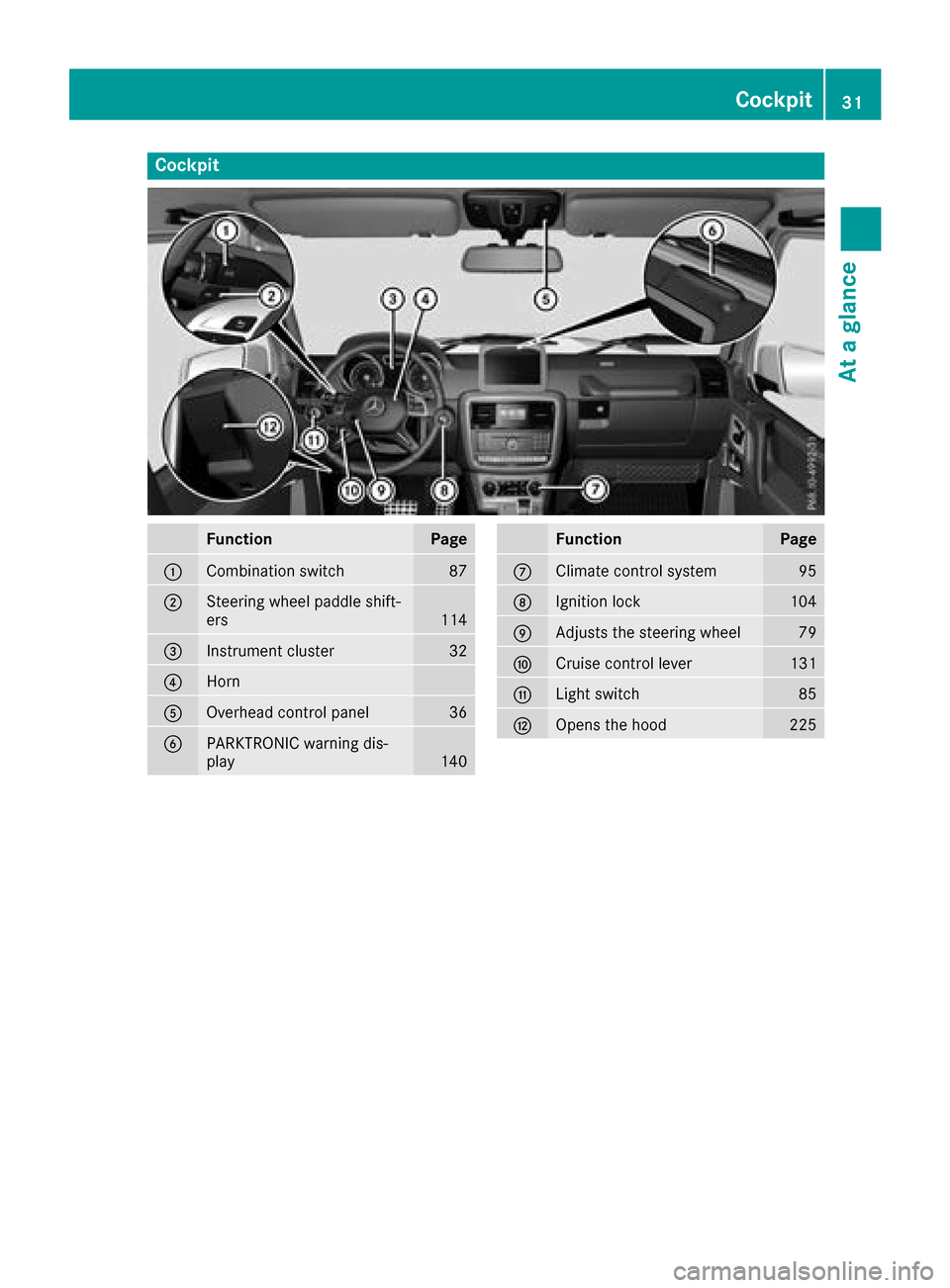
Cockpit
FunctionPage
:Combination switch87
;Steering wheel paddle shift-
ers114
=Instrumentcluster32
?Horn
AOverhead control panel36
BPARKTRONIC warning dis-
play140
FunctionPage
CClimatecontrol system95
DIgnition lock104
EAdjusts th esteering wheel79
FCruis econtrol lever131
GLights witch85
HOpenst hehood225
Cockpit31
Atag lance
Page 40 of 286
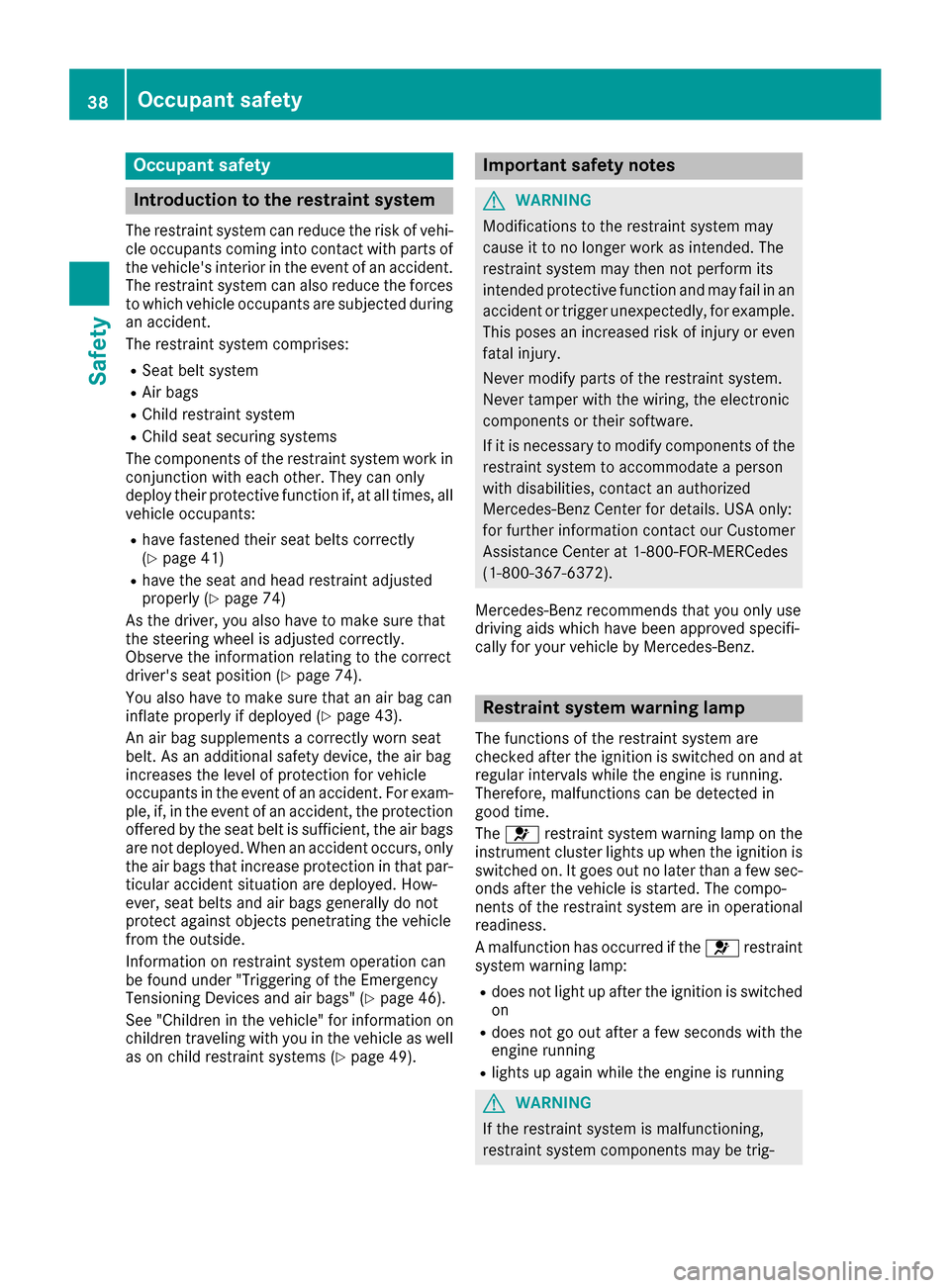
Occupant safety
Introduction to the restraint system
The restraint system can reduce the risk of vehi-cle occupant scomin ginto contact with parts of
the vehicle's interior in the event of an accident.
The restraint system can also reduce the forces to which vehicle occupant sare subjected during
an accident.
The restraint system comprises:
RSeat belt system
RAir bags
RChild restraint system
RChild seat securings ystems
The component softhe restraint system work in
conjunction with each other .They can only
deploy their protective function if, at all times, all
vehicle occupants:
Rhave fastened their seat belts correctly
(Ypage 41)
Rhave the seat and head restraint adjusted
properly (Ypage 74)
As the driver, you also have to make sure that
the steering wheel is adjusted correctly.
Observe the information relating to the correct
driver's seat position (
Ypage 74).
You also have to make sure that an air bag can
inflate properly if deployed (
Ypage 43).
An air bag supplement sacorrectly worn seat
belt. As an additional safety device, the air bag
increases the level of protection for vehicle
occupant sinthe event of an accident. For exam-
ple, if, in the event of an accident, the protection
offered by the seat belt is sufficient, the air bags
are not deployed. When an accidento ccurs,only
the air bags that increase protection in that par- ticular accidents ituation are deployed. How-
ever, seat belts and air bags generally do not
protec tagainst objects penetratin gthe vehicle
from the outside.
Information on restraint system operation can
be found under "Triggering of the Emergency
Tensioning Devices and air bags" (
Ypage 46).
See "Children in the vehicle" for information on
children travelin gwith you in the vehicle as well
as on child restraint systems (
Ypage 49).
Important safetyn otes
GWARNING
Modifications to the restraint system may
cause it to no longer work as intended. The
restraint system may then not perform its
intended protective function and may fail in an
accidentort rigger unexpectedly, for example.
This poses an increased risk of injur yoreven
fatal injury.
Never modify parts of the restraint system.
Never tamper with the wiring, the electronic
component sortheir software.
If it is necessary to modify component softhe
restraint system to accommodate aperson
with disabilities, contact an authorized
Mercedes-Benz Center for details. USA only:
for further information contact our Customer
Assistance Center at 1-800-FOR-MERCedes
(1‑ 800‑367‑ 6372).
Mercedes-Benz recommends that you only use
driving aids which have been approved specifi-
cally for your vehicle by Mercedes-Benz.
Restraint system warning lamp
The function softhe restraint system are
checked after the ignition is switched on and at
regular intervals while the engin eisrunning.
Therefore, malfunctions can be detected in
good time.
The 6 restraint system warning lamp on the
instrument cluster lights up when the ignition is
switched on. It goes out no later than afew sec-
onds after the vehicle is started. The compo-
nents of the restraint system are in operational
readiness.
Am alfunction has occurred if the 6restraint
system warning lamp:
Rdoes not light up after the ignition is switched
on
Rdoes not go out after afew seconds with the
engin erunning
Rlights up again while the engin eisrunning
GWARNING
If the restraint system is malfunctioning,
restraint system component smay be trig-
38Occupant safety
Safety
Page 49 of 286
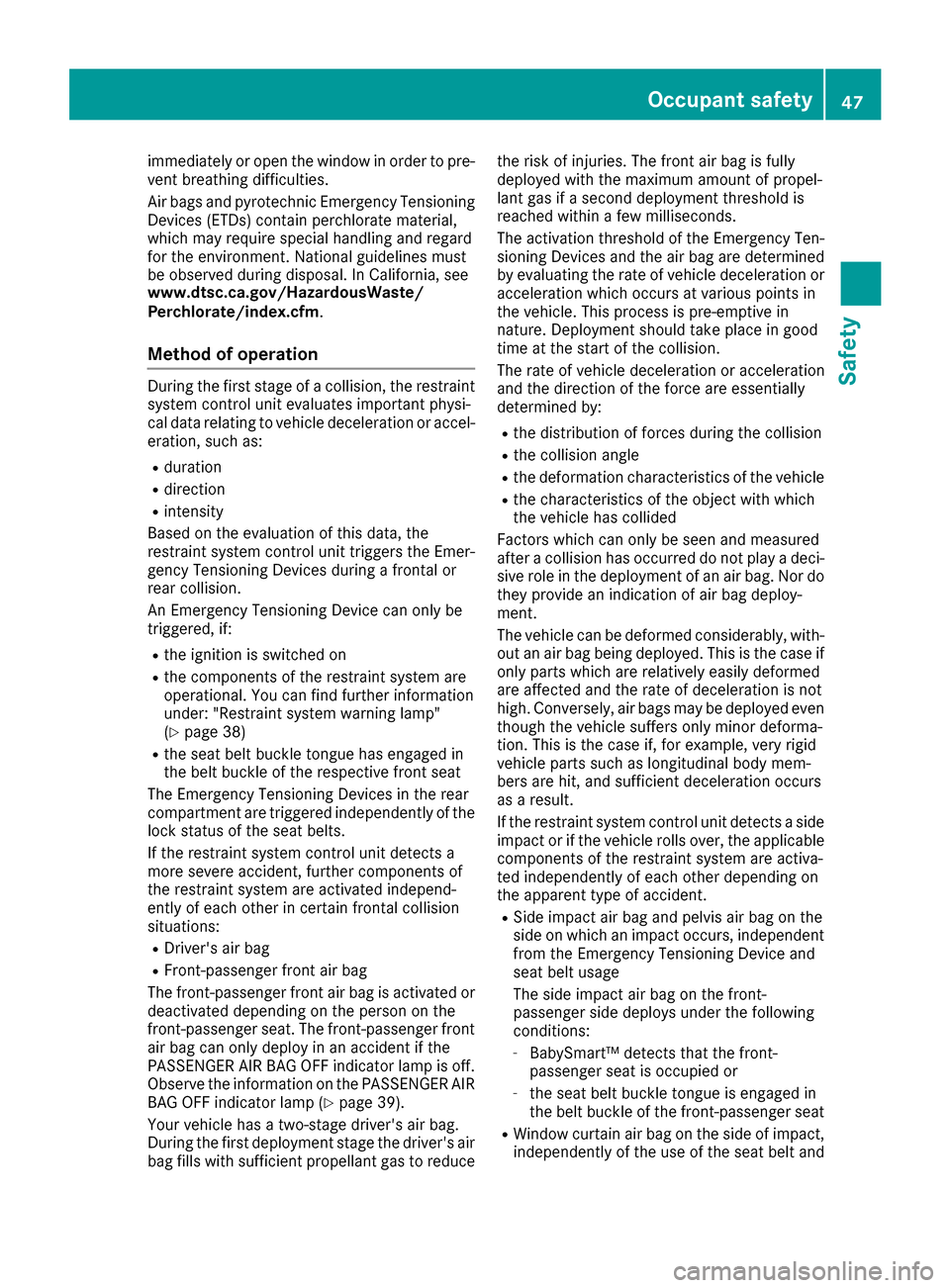
immediately or open the window in order to pre-
ventbreathing difficulties.
Air bags and pyrotechnic Emergency Tensioning
Devices (ETDs) contain perchloratem aterial,
which may require special handlin gand regard
for the environment. National guideline smust
be observed duringd isposal. In California, see
www.dtsc.ca.gov/HazardousWaste/
Perchlorate/index.cfm .
Method of operation
Duringthe firsts tageofac ollision, the restraint
system control unit evaluate simportan tphysi-
cal data relating to vehicle deceleratio noraccel-
eration, such as:
Rduration
Rdirection
Rintensity
Based on the evaluatio nofthis data, the
restraint system control unit triggers the Emer-
genc yTensionin gDevices duringaf rontal or
rear collision.
An Emergency Tensionin gDevice can only be
triggered, if:
Rthe ignition is switched on
Rthe component softhe restraint system are
operational. You can findf urther information
under :"Restraint system warnin glamp"
(
Ypage 38)
Rthe seat belt buckle tongue has engaged in
the belt buckle of the respective front seat
The Emergency Tensionin gDevices in the rear
compartmenta re triggeredindependently of the
lock status of the seat belts.
If the restraint system control unit detect sa
more severea ccident,further component sof
the restraint system are activate dindepend-
ently of each other in certain frontal collision
situations:
RDriver'sa ir bag
RFront-passenge rfront air bag
The front-passenge rfront air bag is activate dor
deactivate ddepending on the personont he
front-passenge rseat. The front-passenge rfront
air bag can only deploy in an accident if the
PASSENGER AI RBAG OFF indicator lamp is off.
Observe the information on the PASSENGER AIR
BA GO FF indicator lamp (
Ypage 39).
Your vehicle has atwo-stag edriver's air bag.
Durin gthe firstd eployments tagethe driver's air
bag fills with sufficient propellantg as to reducet
he risk of injuries. The front air bag is fully
deployed with the maximum amount of propel-
lant gas if asecond deploymentt hreshold is
reached within afew milliseconds.
The activatio nthreshold of the Emergency Ten-
sioning Devices and the air bag are determined
by evaluatin gthe rate of vehicle deceleratio nor
acceleration which occurs at various point sin
the vehicle. This process is pre-emptive in
nature. Deployment should tak eplace in good
tim eatt he star tofthe collision.
The rate of vehicle deceleratio noracceleration
and the direction of the force are essentially
determined by:
Rthe distribution of forces duringt he collision
Rthe collision angle
Rthe deformationcharacteristics of the vehicle
Rthe characteristics of the object with which
the vehicle has collided
Factor swhich can only be seen and measured
after acollision has occurred do not play adeci-
sive role in the deploymentofana ir bag. Nor do
the yprovide an indication of air bag deploy-
ment.
The vehicle can be deformed considerably, with-
out an air bag being deployed. This is the case if
only partsw hich are relatively easily deformed
are affected and the rate of deceleratio nisnot
high. Conversely, air bags may be deployed even
though the vehicle suffers only minor deforma-
tion .This is the case if, for example, very rigid
vehicle partss uch as longitudinal body mem-
bers are hit, and sufficient deceleratio noccurs
as aresult.
If the restraint system control unit detect saside
impact or if the vehicle rolls over,t he applicable
component softhe restraint system are activa-
ted independently of each other depending on
the apparentt ype of accident .
RSide impact air bag and pelvis air bag on the
side on which an impact occurs, independent
fromt
he Emergency Tensionin gDevice and
seat belt usage
The side impact air bag on the front-
passenger side deploys under the following
conditions:
-BabySmart™ detect sthat the front-
passenger seat is occupied or
-the seat belt buckle tongue is engaged in
the belt buckle of the front-passenge rseat
RWindo wcurtain air bag on the side of impact,
independently of the use of the seat belt and
Occupant safety47
Safety
Z
Page 55 of 286

XRemove cargo compartmentcover
(Ypage 209).
XMov ethe head restrain tup.
XInstall th eLATCH-type (ISOFIX) child restrain t
system wit hTop Tether .Always comply wit h
th ec hild restrain tsystem manufacturer' s
installation instruction swhen doin gso.
XRout eTop Tether belt =under th ehead
restrain tbetween th etwo head restrain tbars .
XHook Top Tether hoo k: of Top Tether belt
= intoT op Tether anchorage ;.
Mak esuret hatT op Tether belt =is no ttwis-
ted.
XTension Top Tether belt =.Always comply
wit hthe child restrain tsystem manufactur -
er' sinstallation instruction swhen doin gso.
XMov ehead restrain tbackd own again slightly
if necessar y(Ypage 77). Mak esuret hat
you do no tinterfere wit hthe correc trouting of
Top Tether belt =.
BabySmart™air bag deactivation sys-
tem
GWARNIN G
Electronic device sonthefront-passenger
seat can affec tthe function of th eBaby-
Smart ™air bag deactivation system, for
example:
RLaptop
RMobile phon e
RTransponder cards suc hasskipasses or
access passes
The front-passenger air bag could deplo yacci-
dentally or no tfunction as intended during an
accident. This poses an increased ris kof
injury or eve nfatal injury.
Do no tplac ea ny of th edevice smentioned
abov eors imilar device sonthefront-
passenger seat .Beaware of th estatus of th e
front-passenger fron tair bag bot hbefore and
during th ejou rney.
The BabySmart ™air bag deactivation system' s
sensor system in th efront-pa ssenger seat
detects whether aspecial Mercedes-Ben zchild
restrain tsystem wit hatransponder for th e
BabySmart ™air bag deactivation system has been installed. In this case, th
ePASSENG ER AIR
BA GO FFindicator lamp lights up and remain s
lit .T he front-passenger fron tair bag is deacti -
vated.
When th eSma rtKey is remove dfromt heignition
loc korisinp osition0,thePASSENGER AI RBAG
OF Findicator lamp does no tligh tup.
iIf th efront-pa ssenger fron tair bag is deac -
tivated by th eBabySmart ™air bag deactiva-
tion system, th ef
o
llowin gremain enabled on
th ef ront-pa ssenger side :
Rthes ide impact air bag
Rthep elvis air bag
Rthew indow curtai nair bag
RtheE me rgency Tensioning Devic e
GWARNING
If you secure achild in achild restrain tsystem
on th efront-pa ssenger seat and th e
PASSENGER AI RBAG OFFindicator lamp is
off ,the front-passenger fron tair bag can
deplo yintheevent of an accident. The child
could be struc kbytheair bag. This poses an
increased ris kofinjury or eve nfatal injury.
Mak esuret hatthe front-passenger fron tair
bag has been disabled. The PASSENGER AI R
BA GO FFindicator lamp mus tbelit.
GWARNIN G
If th ePASSENG ER AIRBAG OFFindicator
lamp is lit ,the front-passenger fron tair bag is
deactivated. It will no tbedeployed in th e
event of an acciden tand canno tperfor mits
intended protective function .Aperson in th e
front-passenger seat could then ,for example,
come int ocontac twitht he vehicle's interior,
especially if th eperson is sitting to oclose to
th ed ashboard. This poses an increased ris kof
injury or eve nfatal injury.
In this cas ethe front-passenger seat may no t
be used .You may only transpor tachild on th e
front-passenger seat if they are seated in a
suitable rearward or forward-facing child
restrain tsystem. Always observ ethe child
restrain tsystem manufacturer' sinstallation
instructions.
Children in th evehicle53
Safety
Z
Page 57 of 286
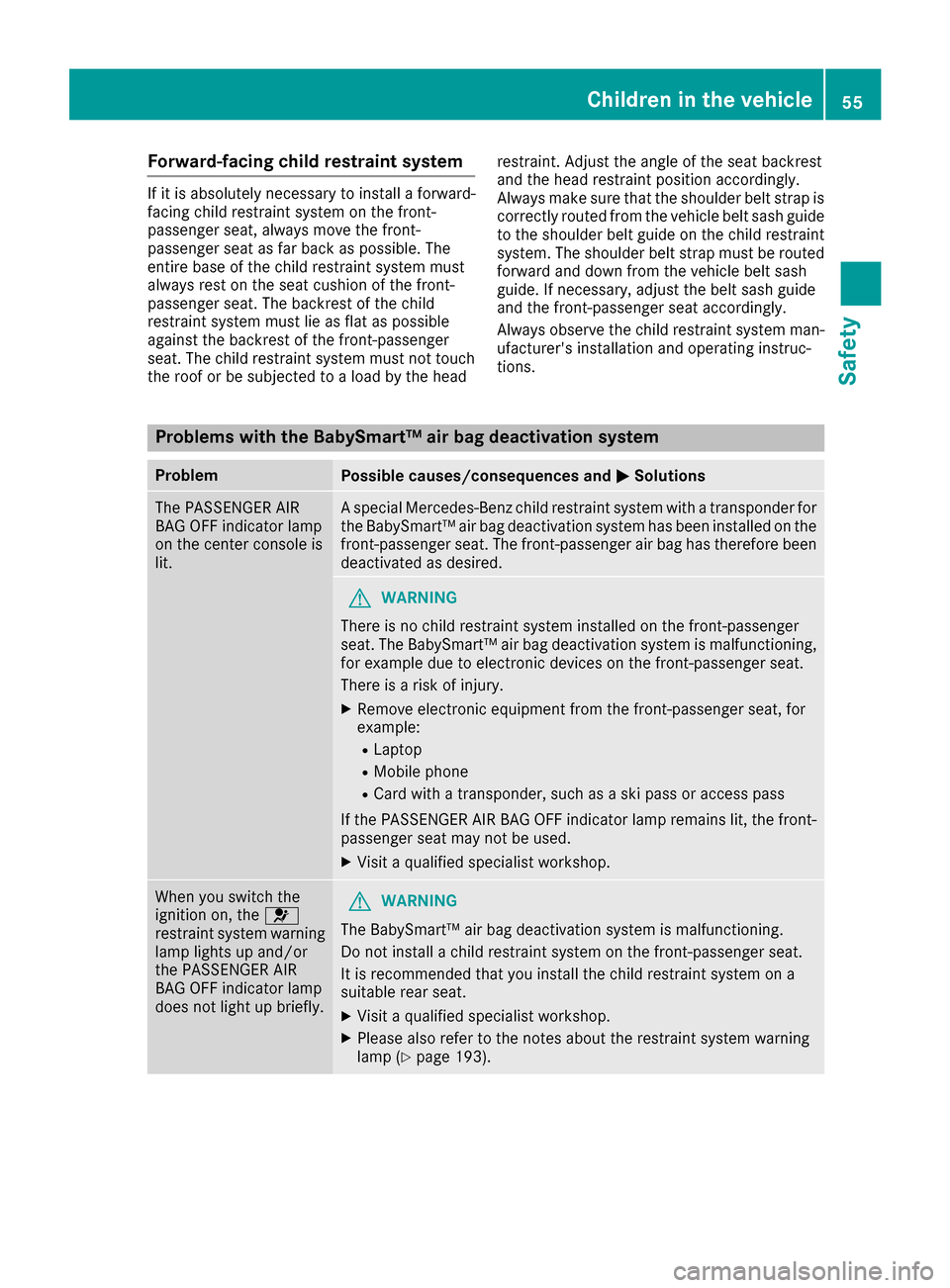
Forward-facingchild restrain tsystem
If it is absolutely necessar ytoinstal laforward-
facing child restrain tsystem on th efront -
passenger seat ,always mov ethe front-
passenger seat as far bac kaspossible. The
entire base of th echild restrain tsystem must
always res tontheseat cushion of th efront -
passenger seat .The backrest of th echild
restrain tsystem must lie as flat as possible
against th ebackrest of th efront-pa ssenger
seat .The child restrain tsystem must no ttou ch
th er ooforbes ubjected to aload by th ehead restraint
.Adjus tthe angle of th eseat backrest
and th ehead restraint position accordingly.
Always mak esure that th eshoulder belt strap is
correctly routed from th evehicl ebelt sash guide
to th eshoulder belt guide on th echild restrain t
system. The shoulder belt strap must be routed
forward and down from th evehicl ebelt sash
guide .Ifnecessary, adjust th ebelt sash guide
and th efront-pa ssenger seat accordingly.
Always observ ethe child restraint system man -
ufacturer' sinstallation and operating instruc-
tions.
Problemsw ith theBabySmart ™air bag deactivation system
ProblemPossible causes/consequences and MSolutions
The PASSENGER AIR
BA GO FFindicator lamp
on th ecente rconsol eis
lit .As pecial Mercedes-Ben zchild restrain tsystem wit hatransponder for
th eB abySmart ™air bag deactivation system has been installed on th e
front-passenger seat .The front-passenger air bag has therefor ebeen
deactivated as desired .
GWARNING
Ther eisnoc hild restrain tsystem installed on th efront-pa ssenger
seat .The BabySmart ™air bag deactivation system is malfunctioning ,
for example due to electronic device sonthefront-passenger seat .
Ther eisar iskofi njury.
XRemove electronic equipmen tfromt hefront-passenger seat ,for
example:
RLaptop
RMobile phon e
RCard withatransponder ,suc hasas kipass or access pass
If th ePASSENG ER AIRBAG OFFindicator lamp remains lit ,the front-
passenger seat may no tbeused.
XVisitaqualified specialist workshop.
When you switch th e
ignition on ,the 6
restrain tsystem warning
lamp lights up and/o r
th eP ASSENG ER AIR
BA GO FFindicator lamp
does no tligh tupb riefly.GWARNIN G
The BabySmart ™air bag deactivation system is malfunctioning .
Do no tinstal lachild restraint system on th efront-pa ssenger seat .
It is recommended that you instal lthe child restraint system on a
suitable rear seat .
XVisitaqualified specialist workshop.
XPleas ealso refer to th enotes about th erestraint system warning
lamp (Ypage 193).
Children in th evehicle55
Safety
Z
Page 59 of 286
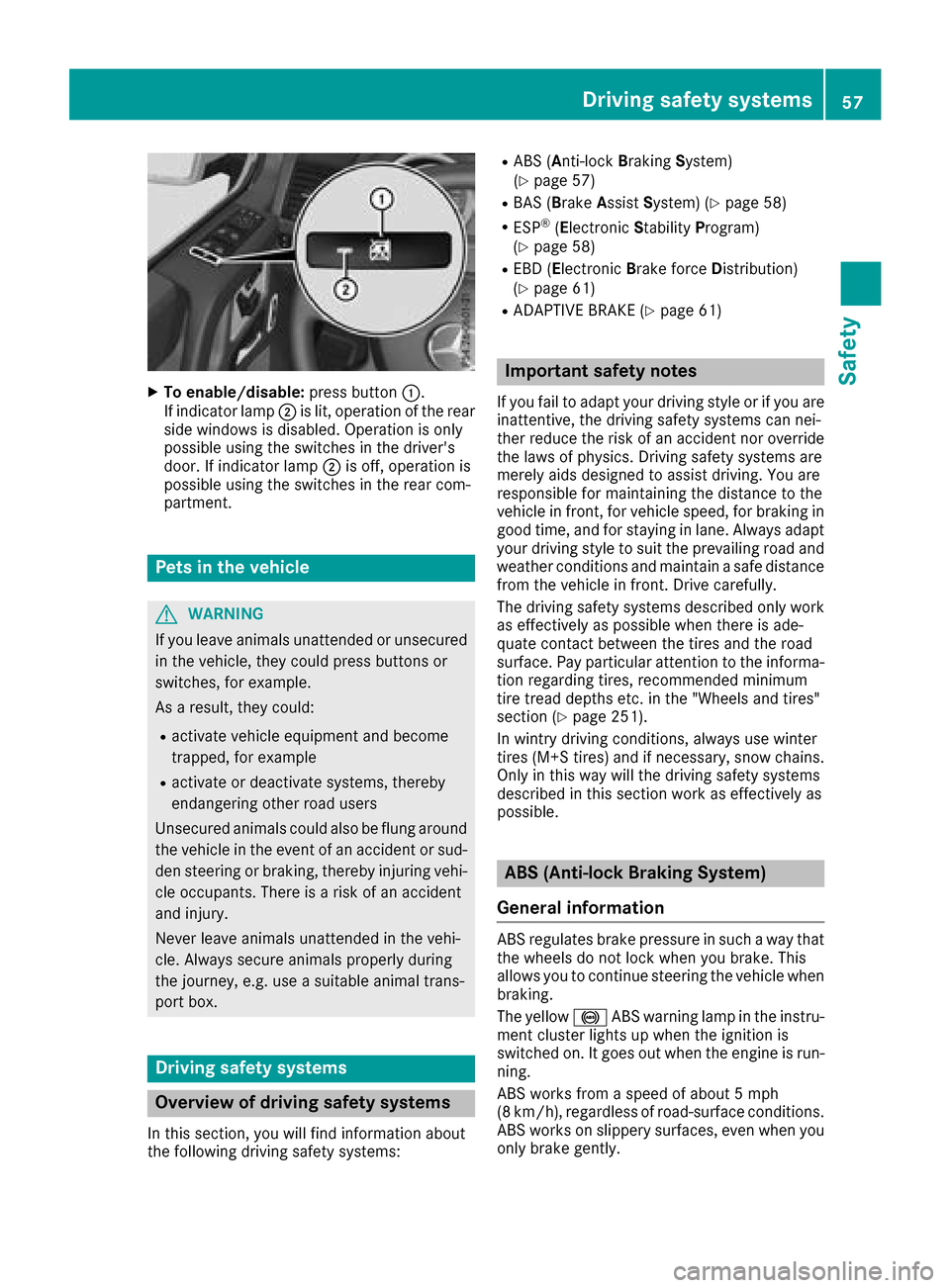
XTo enable/disable:press button:.
If indicator lamp ;is lit, operatio nofthe rear
side windows is disabled .Operation is only
possibl eusing the switches in the driver's
door. If indicator lamp ;is off, operatio nis
possibl eusing the switches in the rearc om-
partment.
Pets in the vehicle
GWARNING
If yo ulea ve animals unattende dorunsecured
in the vehicle, they could press buttons or
switches, for example.
As aresult, they could:
Ractivate vehicl eequipment and become
trapped, for example
Ractivate or deactivate systems, thereby
endangering othe rroadu sers
Unsecured animals could also be flung around
the vehicl einthe event of an accident or sud-
de ns teering or braking ,thereb yinjuring vehi-
cle occupants. There is ariskofana ccident
and injury.
Never leave animals unattende dinthe vehi-
cle .Alway ssecure animals properly during
the journey ,e.g.u se asuitabl eanimal trans-
port box.
Driving safety systems
Overvie wofdriving safety systems
In thiss ection, yo uwillf ind informatio nabout
the following driving safety systems:
RABS ( Anti-lock Braking System)
(Ypage 57)
RBAS ( Brake Assis tSys tem )(Ypage 58)
RESP®(E le ctronic Stability Program)
(Ypage 58)
REBD ( Ele ctronic Brake force Dis tribution)
(Ypage 61)
RADAPTIVE BRAK E(Ypage 61)
Important safety notes
If youfailtoa dapt your driving style or if yo uare
inattentive, the driving safety systemsc an nei-
ther reduce the ris kofanaccident nor override
the laws of physics. Driving safety systemsa re
merel yaidsd esig ned to assist driving .You are
responsibl efor maintaining the distance to the
vehicl einfront, for vehicl espeed ,for braking in
goo dtime ,and for staying in lane. Alway sadapt
your driving style to suit the prevailing roada nd
weather conditions and maintain asafed istance
from the vehicl einfront. Driv ecarefully.
The driving safety systemsd escribe donlyw ork
as effectively as possibl ewhent her eisa de-
quate contact between the tire sand the road
surface. Payp articula rattentio ntothe informa-
tio nr egarding tires, recommende dminimum
tire trea ddepths etc. in the "Wheels and tires"
section (
Ypage 251).
In wintry driving conditions, always us ewinter
tire s(M+ Stires) and if necessary,s now chains.
Onlyint hiswaywill the driving safety systems
describe dinthissection work as effectively as
possible.
ABS (Anti-lock Brakin gSystem)
General information
ABS regulate sbrake pressure in such awaythat
the wheels do not lock when yo ubrake. This
allows yo utocontinue steering the vehicl ewhen
braking.
The yellow !ABS warning lamp in the instru-
ment cluster lights up when the ignition is
switched on. It goe soutwhen the engine is run-
ning.
ABS works from aspeed of about5m ph
(8 km/h), regardless of road-surface conditions.
ABS works on slippery surfaces, eve nwheny ou
onlyb rake gently.
Driving safety systems57
Safety
Z